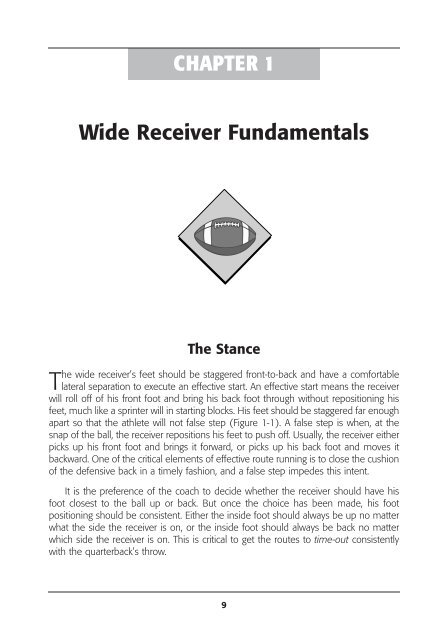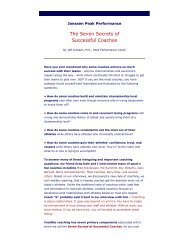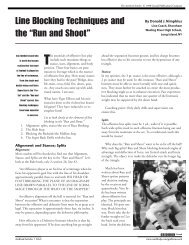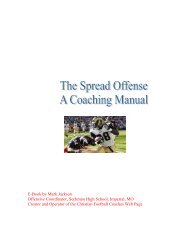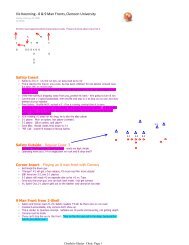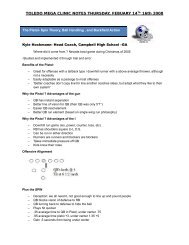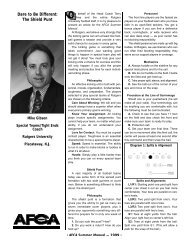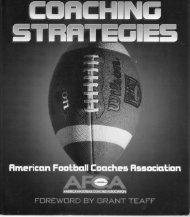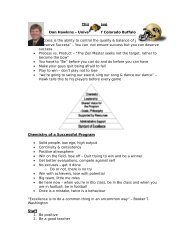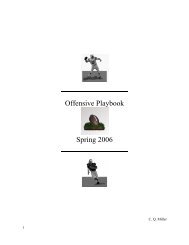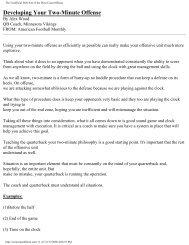Wide Receiver Fundamentals.pdf - Fast and Furious Football
Wide Receiver Fundamentals.pdf - Fast and Furious Football
Wide Receiver Fundamentals.pdf - Fast and Furious Football
Create successful ePaper yourself
Turn your PDF publications into a flip-book with our unique Google optimized e-Paper software.
The receiver also has to pay attention to his arm movements. He should alwaysconcentrate on arm movement that simulates the movements used when running.Some receivers will drop their arms, stick their arms out, or even raise their arms up inthe air when they start to breakdown. This is an obvious signal that a receiver is aboutto make a move, <strong>and</strong> tips off the defender, allowing him to prepare for it.Vertical PushVertical push is one of the most important tools for today’s wide receiver. Vertical pushis the ability to get downfield as quickly as possible to create problems for thedefensive secondary. Remember, the further you get downfield, the fewer the numberof defenders available to cover the whole field. In addition, by getting vertical push asquickly as possible, you force the defender to make reactionary adjustments.Of course, it helps if receivers have great speed, but the principals of vertical pushcan be utilized by individual receivers if they underst<strong>and</strong> that they have to do the bestthey can to get downfield as fast as they can. Hesitation moves <strong>and</strong> counter routesdon’t really do anything unless the receiver (<strong>and</strong> the offense) runs full speed duringevery single given play.Creating SeparationCreating separation refers to the receiver’s ability to break away from a defender justas the football is being thrown to him. The receiver should be catching the ball in spaceto create yardage after the catch.Creating separation requires the receiver first know how to set up <strong>and</strong> generate asituation where he can get maximum separation at an advantageous point in the route.The receiver must then be in complete control of his body <strong>and</strong> how he runs the passroute. To do this takes hours of refinement <strong>and</strong> proper instruction. The receiver must reacton the football field <strong>and</strong> do the thinking in practice. Most importantly, creating greatseparation requires that the receiver get into, <strong>and</strong> out of, his breaks cleanly <strong>and</strong> efficiently.Catching the <strong>Football</strong>Catching the football is one of the most important aspects of being a wide receiver.Your receivers could be the fastest player on the team <strong>and</strong> run the best routes, <strong>and</strong>also have the innate ability to create a big play after the catch with a great run, but ifthey don’t catch the football, the play is wasted, <strong>and</strong> the clock stops--period. Thefollowing are 10 simple rules your receivers should know when catching the football(these rules will be exp<strong>and</strong>ed on in the remainder of this chapter):12
• The receiver should reach out to catch the pass (he shouldn’t try to catch it againsthis body).• The receiver should watch the ball into his h<strong>and</strong>s.• The receiver should catch the football with his fingertips.• The receiver should catch the football with his palms up when running away fromthe quarterback (unless the ball is thrown behind him — then he should comeback <strong>and</strong> get it at its highest point with his palms out — See Figure 1-4).• When catching a pass in stride, the receiver should always wait until the last secondbefore reaching out for the football.• The receiver should catch the football with his palms out when running towardsthe quarterback (except if the ball is at his stomach level or below).• The receiver should use his body as a shield when going up for the ball in traffic.• The receiver should catch the pass first, <strong>and</strong> then make the run.• When the ball is in the air, the receiver should go get it. Rather than waiting for it,he should come back to the football whenever possible.• The receiver should catch the ball with two h<strong>and</strong>s; it is rare that receivers makeone-h<strong>and</strong>ed catches consistently.The ability to catch the football is predominantly mental, which means that anyonecan become a better pass catcher with the proper technique, lots of repetitions, <strong>and</strong>the ability to focus on the football when the ball is in the air. This is accomplished inteam practice sessions <strong>and</strong> lots of individual work.The most important thing to be aware of is that the ability to make all the catchesin game situations starts with thinking about <strong>and</strong> planning how to catch each givenpass in practice. The receivers should be getting lots of repetitions catching the ball theproper way. This will produce muscle memory making those catches in game situationsautomatic. If the receiver has to think about how to catch a given pass when it’shappening in a game, the chances of catching that pass decrease dramatically.It’s vital for a receiver to catch the football away from his body, so he can see thefootball make contact with his h<strong>and</strong>s. When a receiver lets the football hit his body, hehas less control over the catch <strong>and</strong> the football can easily bounce off his body, or slipthrough his arms.It is also important for him to come back to the football whenever possible (Figure1-4). This creates immediate separation from the defender, if he doesn’t already have it.13
Figure 1-4.• The receiver is reaching outfor the football <strong>and</strong> catching itwith palms out. He is alsocoming back to the football.When you tell your receivers to catch the football with your h<strong>and</strong>s, you are actuallytelling them to catch the football with your fingertips. This allows a certain amount ofgive that keeps the ball from bouncing off the palm of their h<strong>and</strong>s (Figure 1-5).Figure 1-5.• The catch is made with the fingertips, whichallows the give necessary to prevent the ballfrom bouncing off the palms of the h<strong>and</strong>.When a receiver is running a route away from the quarterback (corner routes,streaks, <strong>and</strong> posts), he should have his h<strong>and</strong>s open so his palms are facing the sky.The reason for this is because as he runs away from the quarterback, he wants to keephis momentum going in the same direction of the football. Placing his h<strong>and</strong>s any otherway forces him to turn his body <strong>and</strong> reduces his speed. In addition, having you’re hish<strong>and</strong>s palms up increases his reach (Figure 1-6).14
When catching any pass, especially passes where the receiver is running full speeddownfield, it is critical that he doesn’t reach for the ball too early. This will slow himdown considerably, <strong>and</strong> will throw off his balance. It is impossible for a receiver to runat top speed with his arms stretched out for the pass. He must wait until the lastsecond before reaching for the football (Figure 1-8).Figure 1-8.• The receiver is running a deep route. It’s veryimportant that he wait until the last possiblesecond to reach out <strong>and</strong> catch the football.This allows him to keep his speed <strong>and</strong> runthrough the football.• Catching the ball with palms up increases hisreach.• Putting his h<strong>and</strong>s out too soon will slow himdown considerably.When the receiver runs a curl route, or any route when he is back coming towardsthe quarterback, he should reach for the pass with his h<strong>and</strong>s palms out (except whenthe pass is going to be caught at or below the stomach level). He should reach out forthe football <strong>and</strong> catch it with his h<strong>and</strong>s. Many times, if it hits his body, it can bounceoff of his pads because he can’t watch the ball make contact with his body, <strong>and</strong> hispads don’t have any give (Figures 1-9 through 1-11).Sometimes the receiver has to catch the ball in traffic. Maybe he’s running acrossing route over the middle of the field <strong>and</strong> one (or both) of the safeties is comingup to make the play. In this case he should use his body to act as a barrier betweenthe football <strong>and</strong> the defender. Then he will reach out <strong>and</strong> make the catch away fromhis body, <strong>and</strong> prevent the defender from getting his h<strong>and</strong>s on or near the football(Figure 1-12).Many times the receiver will be in a hurry to make a play <strong>and</strong> start running beforehe makes the catch <strong>and</strong> secures the football, resulting in a dropped pass. It is criticalthat he makes the catch first before trying to run with the football. This requiresdiscipline in practice, so it becomes automatic during games. He must make the catchfirst before making any attempt to run downfield with the football.16
Figure 1-9. Figure 1-10. Figure 1-11.The receiver is running a curlroute. He has his palms outbecause the ball is above hismid-section.The receiver is running aroute across the middle ofthe field. Since the ball isabove his mid-section, heshould catch the pass withhis palms out.This receiver is running a curlroute. The ball is thrownbelow his mid-section <strong>and</strong>he should catch the ball withhis palms up.Figure 1-12.• The receiver is using his body here to shieldthe defender from the football. The defenderwill not be able to get to the football.Keep in mind that any ball in the air is intended for an offensive receiver. In otherwords, if the ball is in the air, your receiver should go get it! He should come back tothe football whenever possible. Too many times the ball is in the air <strong>and</strong> the receiverdecides to wait for it to come to him, rather that going after the football. The defenderthen has an opportunity to either knock down the pass before it gets to the receiver,or worse -- the defender has an opportunity to make an interception. <strong>Receiver</strong>s shouldalways try to make the catch, <strong>and</strong> never allow the defender to intercept the pass.17
The receiver might look back for the pass, <strong>and</strong> automatically think he can’t get tothe football, so he gives up on the ball right away. This is one of the worst things areceiver can do. The fact is, many times the receiver is wrong in his assessment, <strong>and</strong>can actually get to the football. All receivers should run through all passes. If a receiveraccelerates to the football every time he looks back for the pass, he will get to manyof the balls he thought he could not get to. This acceleration will also help the receiverseparate from the defender, which will allow the receiver room to make the catch.Finally, the receiver should always attempt to make the catch with both h<strong>and</strong>s. It israre that receivers make one-h<strong>and</strong>ed catches. It does happen, but if he can’t do itconsistently in practice, the chances of doing it in a game are poor. He should alwaysmake catches with both h<strong>and</strong>s. This is a habit that should be engrained in musclememoryduring practices, <strong>and</strong> will then transfer to game situations.18


